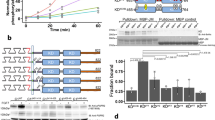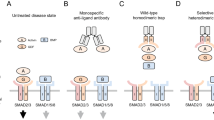Abstract
Transforming growth factor-beta (TGF-β) proteins are a family of structurally related extracellular proteins that trigger their signaling functions through interaction with the extracellular domains of their cognate serine/threonine kinase receptors. The specificity of TGF-β/receptor binding is complex and gives rise to multiple functional roles. Additionally, it is not completely understood at the atomic level. Here, we use the most reliable computational methods currently available to study systems involving activin-like kinase (ALK) receptors ALK4 and ALK7 and their multiple TGF-β ligands. We built models for all these proteins and their complexes for which experimental structures are not available. By analyzing the surfaces of interaction in six different TGF-β/ALK complexes we could infer which are the structural distinctive features of the ligand-receptor binding mode. Furthermore, this study allowed us to rationalize why binding of the growth factors GDF3 and Nodal to the ALK4 receptor requires the Cripto co-factor, whilst binding to the ALK7 receptor does not.






Similar content being viewed by others
Abbreviations
- ActRII:
-
Activin type II receptor
- ACVR1:
-
Activin A type 1 receptor
- ALK:
-
Activin receptor-like kinase
- ASA:
-
Accessible surface area
- BMP:
-
Bone morphogenetic protein
- BMPR1A:
-
Bone morphogenetic protein type 1A receptor or ALK3
- BMPRII:
-
Bone morphogenetic protein type II receptor
- BSA:
-
Buried surface area
- ECD:
-
Extracellular domain
- GDF:
-
Growth/differentiation factor
- MISRII:
-
Mullerian inhibitor substance type II receptor
- PP:
-
Pair potential
- TGF-β:
-
Transforming growth factor-beta
- TGFBRI:
-
Type I TGF-β receptor or ALK5
- TGF-βRII:
-
Type II TGF-β receptor
References
Lin SJ, Lerch TF, Cook RW, Jardetzky TS, Woodruff TK (2006) The structural basis of TGF-beta, bone morphogenetic protein, and activin ligand binding. Reproduction 132:179–190
Shi Y, Massague J (2003) Mechanisms of TGF-beta signaling from cell membrane to the nucleus. Cell 113:685–700
Chang H, Brown CW, Matzuk MM (2002) Genetic analysis of the mammalian transforming growth factor-beta superfamily. Endocr Rev 23:787–823
Kingsley DM (1994) The TGF-beta superfamily: new members, new receptors, and new genetic tests of function in different organisms. Genes Dev 8:133–146
Bierie B, Moses HL (2006) Tumour microenvironment: TGFbeta: the molecular Jekyll and Hyde of cancer. Nat Rev Cancer 6:506–520. doi:10.1038/nrc1926
Pardali K, Moustakas A (2007) Actions of TGF-beta as tumor suppressor and pro-metastatic factor in human cancer. Biochim Biophys Acta 1775:21–62. doi:10.1016/j.bbcan.2006.06.004
Munir S, Xu G, Wu Y, Yang B, Lala PK, Peng C (2004) Nodal and ALK7 inhibit proliferation and induce apoptosis in human trophoblast cells. J Biol Chem 279:31277–31286
Li MO, Flavell RA (2008) TGF-beta: a master of all T cell trades. Cell 134:392–404. doi:10.1016/j.cell.2008.07.025
Watabe T, Miyazono K (2009) Roles of TGF-beta family signaling in stem cell renewal and differentiation. Cell Res 19(1):103–115. doi:10.1038/cr.2008.323
Dennler S, Goumans MJ, ten Dijke P (2002) Transforming growth factor beta signal transduction. J Leukoc Biol 71:731–740
Rosbottom A, Scudamore CL, von der Mark H, Thornton EM, Wright SH, Miller HR (2002) TGF-beta 1 regulates adhesion of mucosal mast cell homologues to laminin-1 through expression of integrin alpha 7. J Immunol 169:5689–5695
Kandasamy M, Reilmann R, Winkler J, Bogdahn U, Aigner L (2011) Transforming growth factor-beta signaling in the neural stem cell niche: a therapeutic target for Huntington's disease. Neurol Res Int 2011:124256. doi:10.1155/2011/124256
Krieglstein K, Strelau J, Schober A, Sullivan A, Unsicker K (2002) TGF-beta and the regulation of neuron survival and death. J Physiol Paris 96:25–30
Hogan BL (1996) Bone morphogenetic proteins: multifunctional regulators of vertebrate development. Genes Dev 10:1580–1594
Massague J (2008) TGFbeta in Cancer. Cell 134:215–230. doi:10.1016/j.cell.2008.07.001
Padua D, Massague J (2009) Roles of TGFbeta in metastasis. Cell Res 19:89–102. doi:10.1038/cr.2008.316
Goumans MJ, Liu Z, ten Dijke P (2009) TGF-beta signaling in vascular biology and dysfunction. Cell Res 19:116–127. doi:10.1038/cr.2008.326
Blobe GC, Schiemann WP, Lodish HF (2000) Role of transforming growth factor beta in human disease. N Engl J Med 342(18):1350–1358. doi:10.1056/NEJM200005043421807
de Caestecker M (2004) The transforming growth factor-beta superfamily of receptors. Cytokine Growth Factor Rev 15:1–11
Barbault F, Landon C, Guenneugues M, Meyer JP, Schott V, Dimarcq JL, Vovelle F (2003) Solution structure of Alo-3: a new knottin-type antifungal peptide from the insect Acrocinus longimanus. Biochemistry 42:14434–14442. doi:10.1021/bi035400o
McDonald NQ, Lapatto R, Murray-Rust J, Gunning J, Wlodawer A, Blundell TL (1991) New protein fold revealed by a 2.3-A resolution crystal structure of nerve growth factor. Nature 354:411–414. doi:10.1038/354411a0
Vitt UA, Hsu SY, Hsueh AJ (2001) Evolution and classification of cystine knot-containing hormones and related extracellular signaling molecules. Mol Endocrinol 15:681–694
Manning G, Whyte DB, Martinez R, Hunter T, Sudarsanam S (2002) The protein kinase complement of the human genome. Science 298:1912–1934
Greenwald J, Fischer WH, Vale WW, Choe S (1999) Three-finger toxin fold for the extracellular ligand-binding domain of the type II activin receptor serine kinase. Nat Struct Biol 6:18–22
Thompson TB, Woodruff TK, Jardetzky TS (2003) Structures of an ActRIIB:activin A complex reveal a novel binding mode for TGF-beta ligand:receptor interactions. EMBO J 22:1555–1566
Sieber C, Kopf J, Hiepen C, Knaus P (2009) Recent advances in BMP receptor signaling. Cytokine Growth Factor Rev 20:343–355
Allendorph GP, Vale WW, Choe S (2006) Structure of the ternary signaling complex of a TGF-beta superfamily member. Proc Natl Acad Sci USA 103:7643–7648
Kirsch T, Sebald W, Dreyer MK (2000) Crystal structure of the BMP-2-BRIA ectodomain complex. Nat Struct Biol 7:492–496
Santibanez JF, Quintanilla M, Bernabeu C (2011) TGF-beta/TGF-beta receptor system and its role in physiological and pathological conditions. Clin Sci (Lond) 121:233–251
Andersson O, Korach-Andre M, Reissmann E, Ibanez CF, Bertolino P (2008) Growth/differentiation factor 3 signals through ALK7 and regulates accumulation of adipose tissue and diet-induced obesity. Proc Natl Acad Sci USA 105:7252–7256
Andersson O, Reissmann E, Ibanez CF (2006) Growth differentiation factor 11 signals through the transforming growth factor-beta receptor ALK5 to regionalize the anterior-posterior axis. EMBO Rep 7:831–837
Chen C, Ware SM, Sato A, Houston-Hawkins DE, Habas R, Matzuk MM, Shen MM, Brown CW (2006) The Vg1-related protein Gdf3 acts in a Nodal signaling pathway in the pre-gastrulation mouse embryo. Development 133:319–329
Reissmann E, Jornvall H, Blokzijl A, Andersson O, Chang C, Minchiotti G, Persico MG, Ibanez CF, Brivanlou AH (2001) The orphan receptor ALK7 and the Activin receptor ALK4 mediate signaling by Nodal proteins during vertebrate development. Genes Dev 15:2010–2022
Walpole IR, Grauaug A (1979) Intra-uterine infection with herpes simplex virus and observed radiological changes. Aust Paediatr J 15:123–125
Tsuchida K, Nakatani M, Uezumi A, Murakami T, Cui X (2008) Signal transduction pathway through activin receptors as a therapeutic target of musculoskeletal diseases and cancer. Endocr J 55:11–21
Levine AJ, Brivanlou AH (2006) GDF3, a BMP inhibitor, regulates cell fate in stem cells and early embryos. Development 133:209–216
Schier AF, Shen MM (2000) Nodal signalling in vertebrate development. Nature 403:385–389
Calvanese L, Marasco D, Doti N, Saporito A, D’Auria G, Paolillo L, Ruvo M, Falcigno L (2010) Structural investigations on the Nodal-Cripto binding: a theoretical and experimental approach. Biopolymers 93:1011–1021
Cash JN, Rejon CA, McPherron AC, Bernard DJ, Thompson TB (2009) The structure of myostatin:follistatin 288: insights into receptor utilization and heparin binding. EMBO J 28:2662–2676
Soding J (2005) Protein homology detection by HMM–HMM comparison. Bioinformatics 21:951–960
Soding J, Biegert A, Lupas AN (2005) The HHpred interactive server for protein homology detection and structure prediction. Nucleic Acids Res 33 (Web Server issue):W244–W248
Fiser A, Sali A (2003) Modeller: generation and refinement of homology-based protein structure models. Methods Enzymol 374:461–491
Baker D, Sali A (2001) Protein structure prediction and structural genomics. Science 294:93–96
Benkert P, Tosatto SC, Schomburg D (2008) QMEAN: A comprehensive scoring function for model quality assessment. Proteins 71:261–277
de Vries SJ, van Dijk M, Bonvin AM (2010) The HADDOCK web server for data-driven biomolecular docking. Nat Protoc 5:883–897
Comeau SR, Gatchell DW, Vajda S, Camacho CJ (2004) ClusPro: an automated docking and discrimination method for the prediction of protein complexes. Bioinformatics 20:45–50
Kozakov D, Brenke R, Comeau SR, Vajda S (2006) PIPER: an FFT-based protein docking program with pairwise potentials. Proteins 65:392–406
Tina KG, Bhadra R, Srinivasan N (2007) PIC: Protein Interactions Calculator. Nucleic Acids Res 35 (Web Server issue):W473–W476
Gohlke H, Hendlich M, Klebe G (2000) Knowledge-based scoring function to predict protein-ligand interactions. J Mol Biol 295:337–356
Kruger DM, Gohlke H DrugScorePPI webserver: fast and accurate in silico alanine scanning for scoring protein-protein interactions. Nucleic Acids Res 38 (Web Server issue):W480–W486
Kortemme T, Kim DE, Baker D (2004) Computational alanine scanning of protein–protein interfaces. Sci STKE 2004 (219):pl2
Tuncbag N, Gursoy A, Keskin O (2009) Identification of computational hot spots in protein interfaces: combining solvent accessibility and inter-residue potentials improves the accuracy. Bioinformatics 25:1513–1520
Wallace AC, Laskowski RA, Thornton JM (1995) LIGPLOT: a program to generate schematic diagrams of protein-ligand interactions. Protein Eng 8:127–134
Acknowledgments
King Abdullah University of Science and Technology (KAUST; Award No. KUK-I1-012-43); Fondazione Roma and the Italian Ministry of Health (contract no.onc_ord 25/07, FIRB ITALBIONET and PROTEOMICA).
Ministero dell’Università e della Ricerca Scientifica (MIUR), project PRIN n° prot. 2008F5A3AF_001.
Author information
Authors and Affiliations
Corresponding author
Additional information
Valentina Romano and Domenico Raimondo contributed equally to this work.
Electronic supplementary material
Below is the link to the electronic supplementary material.
Fig. S1
Topology diagrams of a TGF-β protein (a) and of the extracellular domain of an ALK receptor (b). In both schemes, the β-strands are represented by large arrows in pink and the α-helices are shown as red cylinders. The small blue arrows indicate the directionality of the protein chain, from the N-terminus to the C-terminus. (PDF 33 kb)
Fig. S2
The target–template sequence alignments obtained by HHpred of (a) GDF3 (UniProt ID: Q9NR23) and BMP2, (b) GDF11 (UniProt ID: O95390) and GDF8, (c), ALK4-ECD (UniProt ID: P36896) and ALK5-ECD , (d) ALK7-ECD (UniProt ID: Q8NER5) with ALK5-ECD and ALK3-loop 23. Shaded columns Conserved residues. (PDF 38 kb)
Rights and permissions
About this article
Cite this article
Romano, V., Raimondo, D., Calvanese, L. et al. Toward a better understanding of the interaction between TGF-β family members and their ALK receptors. J Mol Model 18, 3617–3625 (2012). https://doi.org/10.1007/s00894-012-1370-y
Received:
Accepted:
Published:
Issue Date:
DOI: https://doi.org/10.1007/s00894-012-1370-y




